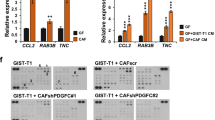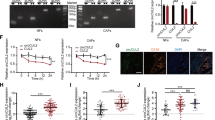Abstract
Background
Inflammatory cancer-associated fibroblasts (iCAFs) was first identified by co-culture of pancreatic stellate cells and tumor organoids. The key feature of iCAFs is IL-6high/αSMAlow. We examine this phenomenon in gastric cancer using two cell lines of gastric fibroblasts (HGF and YS-1).
Methods and results
HGF or YS-1 were co-cultured with MKN7 (a gastric adenocarcinoma cell line) in Matrigel. IL-6 protein levels in the culture supernatant were measured by ELISA. The increased production of IL-6 was not observed in any of the combinations. Instead, the supernatant of YS-1 exhibited the higher levels of IL-6. YS-1 showed IL-6high/αSMA (ACTA2)low in real-time PCR, mRNA-seq and immunohistochemistry. In mRNA-seq, iCAFs-associated genes and signaling pathways were up-regulated in YS-1. No transition to myofibroblastic phenotype was observed by monolayer culture, or the exposure to sonic hedgehog (SHH) or TGF-β. YS-1 conditioned medium induced changes of morphology and stem-ness/differentiation in NUGC-3 (a human gastric adenocarcinoma cell line) and UBE6T-15 (a human bone marrow-derived mesenchymal stem cell line).
Conclusions
YS-1 is a stable cell line of gastric iCAFs. This discovery will promote further research on iCAFs for many researchers.



Similar content being viewed by others
Data availability
All data generated or analyzed during this study are included in this article. The raw data of mRNA-seq will be shared on reasonable request to the corresponding author.
References
Öhlund D, Handly-Santana A, Biffi G et al (2017) Distinct populations of inflammatory fibroblasts and myofibroblasts in pancreatic cancer. J Exp Med 214:579–596
Chen J, Huang X-F (2009) Interleukin-6 promotes carcinogenesis through multiple Signal pathways. Dig Dis Sci 54:1373–1374
Elyada E, Bolisetty M, Laise P et al (2019) Cross-species single-cell analysis of pancreatic ductal adenocarcinoma reveals Antigen-Presenting Cancer-Associated fibroblasts. Cancer Discov 9:1102–1123
Houthuijzen JM, de Bruijn R, van der Burg E et al (2023) CD26-negative and CD26-positive tissue-resident fibroblasts contribute to functionally distinct CAF subpopulations in breast cancer. Nat Commun 14:183
Chen Z, Zhou L, Liu L et al (2020) Single-cell RNA sequencing highlights the role of inflammatory cancer-associated fibroblasts in bladder urothelial carcinoma. Nat Commun 11:1–12
Du YH, Cao J, Jiang X et al (2021) Comprehensive analysis of CXCL12 expression reveals the significance of inflammatory fibroblasts in bladder cancer carcinogenesis and progression. Cancer Cell Int 21:1–15
Chen H, Yang W, Xue X, Li Y, Jin Z, Ji Z (2022) Integrated Analysis revealed an Inflammatory Cancer-Associated fibroblast-based subtypes with Promising implications in Predicting the prognosis and immunotherapeutic response of bladder Cancer patients. Int J Mol Sci 23:15970
Wang Z, Zhang H, Zhai Y, Li F, Shi X, Ying M (2022) Single-cell profiling reveals heterogeneity of primary and Lymph Node Metastatic Tumors and Immune Cell populations and discovers important prognostic significance of CCDC43 in oral squamous cell carcinoma. Front Immunol 13:1–13
Yang W, Zhang S, Li T, Zhou Z, Pan J (2022) Single-cell analysis reveals that cancer-associated fibroblasts stimulate oral squamous cell carcinoma invasion via the TGF-beta/Smad pathway. Acta Biochim Biophys Sin (Shanghai) 55:262–273
Nicolas AM, Pesic M, Engel E et al (2022) Inflammatory fibroblasts mediate resistance to neoadjuvant therapy in rectal cancer. Cancer Cell 40:168–184e13
Peng Z, Ye M, Ding H, Feng Z, Hu K (2022) Spatial transcriptomics atlas reveals the crosstalk between cancer-associated fibroblasts and tumor microenvironment components in colorectal cancer. J Transl Med 20:1–13
Tran LL, Dang T, Thomas R, Rowley DR (2021) ELF3 mediates IL-1α induced differentiation of mesenchymal stem cells to inflammatory iCAFs. Stem Cells 39:1766–1777
Li X, Sun Z, Peng G et al (2022) Single-cell RNA sequencing reveals a pro-invasive cancer-associated fibroblast subgroup associated with poor clinical outcomes in patients with gastric cancer. Theranostics 12:620–638
Wu YS, Chung I, Wong WF, Masamune A, Sim MS, Looi CY (2017) Paracrine IL-6 signaling mediates the effects of pancreatic stellate cells on epithelial-mesenchymal transition via Stat3/Nrf2 pathway in pancreatic cancer cells. Biochim Biophys Acta Gen Subj 1861:296–306
Shi Y, Gao W, Lytle NK et al (2019) Targeting LIF-mediated paracrine interaction for pancreatic cancer therapy and monitoring. Nature 569:131–135
Garg B, Giri B, Modi S et al (2018) NFκB in pancreatic stellate cells reduces infiltration of tumors by cytotoxic T cells and killing of Cancer cells, via Up-regulation of CXCL12. Gastroenterology 155:880–891e8
Hu B, Wu C, Mao H et al (2022) Subpopulations of cancer-associated fibroblasts link the prognosis and metabolic features of pancreatic ductal adenocarcinoma. Ann Transl Med 10:262
Biffi G, Oni TE, Spielman B et al (2019) IL1-Induced JAK/STAT signaling is antagonized by TGFβ to shape CAF heterogeneity in pancreatic ductal adenocarcinoma. Cancer Discov 9:282–301
Steele NG, Biffi G, Kemp SB et al (2021) Inhibition of hedgehog signaling alters fibroblast composition in pancreatic Cancer. Clin Cancer Res 27:2023–2037
Kanda Y (2013) Investigation of the freely available easy-to-use software EZR for medical statistics. Bone Marrow Transpl 48:452–458
Geng X, Chen H, Zhao L et al (2021) Cancer-Associated Fibroblast (CAF) heterogeneity and targeting therapy of CAFs in pancreatic Cancer. Front Cell Dev Biol 9:1–14
Miyazaki Y, Oda T, Mori N, Kida YS (2020) Adipose-derived mesenchymal stem cells differentiate into pancreatic cancer-associated fibroblasts in vitro. FEBS Open Bio 10:2268–2281
Peiffer R, Boumahd Y, Gullo C et al (2023) Cancer-Associated Fibroblast Diversity shapes Tumor Metabolism in Pancreatic Cancer. Cancers (Basel) 15:61
Sunami Y, Chen Y, Trojanowicz B et al (2022) Single cell analysis of cultivated fibroblasts from chronic pancreatitis and pancreatic Cancer patients. Cells 11:2583
Seeneevassen L, Martin OCB, Lehours P, Dubus P, Varon C (2022) Leukaemia inhibitory factor in gastric cancer: friend or foe? Gastric Cancer 25:299–305
Chondronasiou D, Martínez de Villarreal J, Melendez E et al (2022) Deciphering the roadmap of in vivo reprogramming toward pluripotency. Stem Cell Rep 17:2501–2517
Takaishi S, Okumura T, Tu S et al (2009) Identification of gastric cancer stem cells using the cell surface marker CD44. Stem Cells 27:1006–1020
Niwa H, Ogawa K, Shimosato D, Adachi K (2009) A parallel circuit of LIF signalling pathways maintains pluripotency of mouse ES cells. Nature 460:118–122
Boyd LNC, Andini KD, Peters GJ et al (2022) Heterogeneity and plasticity of cancer-associated fibroblasts in the pancreatic tumor microenvironment. Semin Cancer Biol 82:184–196
Zheng S, Hu C, Lin H et al (2022) circCUL2 induces an inflammatory CAF phenotype in pancreatic ductal adenocarcinoma via the activation of the MyD88-dependent NF-κB signaling pathway. J Experimental Clin Cancer Res 41:1–23
Mello AM, Ngodup T, Lee Y et al (2022) Hypoxia promotes an inflammatory phenotype of fibroblasts in pancreatic cancer. Oncogenesis 11:56
Schwoerer S, Cimino FV, Ros M et al (2023) Hypoxia potentiates the inflammatory fibroblast phenotype promoted by pancreatic cancer cell-derived cytokines. Cancer Res 83:1596–1610
Vaish U, Jain T, Are AC, Dudeja V (2021) Cancer-associated fibroblasts in pancreatic ductal adenocarcinoma: an update on heterogeneity and therapeutic targeting. Int J Mol Sci 22:13408
Maeda K, Enomoto A, Hara A, Asai N, Kobayashi T, Horinouchi A et al (2016) Identification of Meflin as a potential marker for mesenchymal stromal cells. Sci Rep 6:1–15
Urbaìn N, Cheung TH (2021) Stem cell quiescence: the challenging path to activation. Dev (Cambridge) 148:dev165084
Prado MM, Frampton AE, Stebbing J, Krell J (2015) Gene of the month: NANOG. J Clin Pathol 68:763–765
Lu X, Mazur SJ, Lin T, Appella E, Xu Y (2014) The pluripotency factor nanog promotes breast cancer tumorigenesis and metastasis. Oncogene 33:2655–2664
Almeida GM, Pereira C, Park J-H et al (2021) CD44v6 High Membranous expression is a predictive marker of Therapy Response in Gastric Cancer patients. Biomedicines 9:1249
Bourguignon LYW, Peyrollier K, Xia W, Gilad E (2008) Hyaluronan-CD44 interaction activates stem cell marker nanog, Stat-3-mediated MDR1 gene expression, and ankyrin-regulated multidrug efflux in breast and ovarian tumor cells. J Biol Chem 283:17635–17651
Numakura S, Uozaki H, Kikuchi Y, Watabe S, Togashi A, Watanabe M (2019) Mesenchymal stem cell marker expression in gastric cancer stroma. Anticancer Res 39:387–393
Acknowledgements
YS-1 cells were donated by Dr. Yutaka Shimada (Department of Nanobio Drug Discovery Graduate School of Pharmaceutical Sciences, Kyoto University) via the JCRB Cell Bank (https://cellbank.nibiohn.go.jp/). DNA Chip Research Inc. acquired mRNA-seq read count data from frozen cultured cells. This research was funded by the Japan Society for the Promotion of Science (JSPS) KAKENHI, grant number 20K16203.
Funding
This research was funded by the Japan Society for the Promotion of Science (JSPS) KAKENHI, grant number 20K16203.
Author information
Authors and Affiliations
Contributions
S.N and H.U contributed to the study conception. S.N and M.K contributed investigation. S.N, M.K and H.U contributed validation. S.N contributed the project administration, funding acquision, methodology, data curation, formal analysis, visualization and writing original draft preparation. H.U reviewed and edited the draft and supervised the study.
Corresponding author
Ethics declarations
Ethical approval
Human cell lines were obtained from a donor and providers who have adequate ethical considerations.
Consent to participate
Not applicable.
Consent to publish
Not applicable.
Competing interests
The authors have no relevant financial or non-financial interests to disclose.
Additional information
Publisher’s Note
Springer Nature remains neutral with regard to jurisdictional claims in published maps and institutional affiliations.
Rights and permissions
Springer Nature or its licensor (e.g. a society or other partner) holds exclusive rights to this article under a publishing agreement with the author(s) or other rightsholder(s); author self-archiving of the accepted manuscript version of this article is solely governed by the terms of such publishing agreement and applicable law.
About this article
Cite this article
Numakura, S., Kato, M. & Uozaki, H. Discovery of YS-1 as a cell line of gastric inflammatory cancer-associated fibroblasts. Mol Biol Rep 51, 542 (2024). https://doi.org/10.1007/s11033-024-09442-4
Received:
Accepted:
Published:
DOI: https://doi.org/10.1007/s11033-024-09442-4




